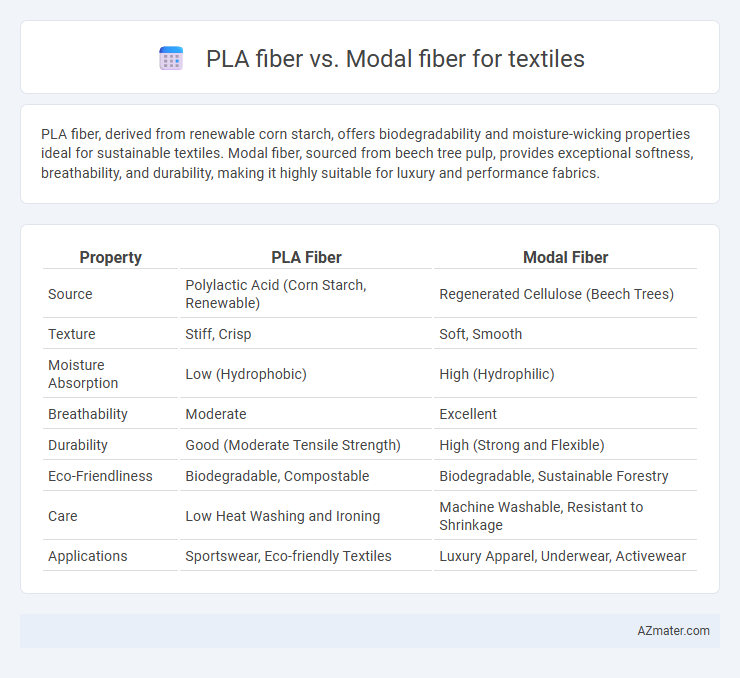PLA fiber, derived from renewable corn starch, offers biodegradability and moisture-wicking properties ideal for sustainable textiles. Modal fiber, sourced from beech tree pulp, provides exceptional softness, breathability, and durability, making it highly suitable for luxury and performance fabrics.
Table of Comparison
| Property | PLA Fiber | Modal Fiber |
|---|---|---|
| Source | Polylactic Acid (Corn Starch, Renewable) | Regenerated Cellulose (Beech Trees) |
| Texture | Stiff, Crisp | Soft, Smooth |
| Moisture Absorption | Low (Hydrophobic) | High (Hydrophilic) |
| Breathability | Moderate | Excellent |
| Durability | Good (Moderate Tensile Strength) | High (Strong and Flexible) |
| Eco-Friendliness | Biodegradable, Compostable | Biodegradable, Sustainable Forestry |
| Care | Low Heat Washing and Ironing | Machine Washable, Resistant to Shrinkage |
| Applications | Sportswear, Eco-friendly Textiles | Luxury Apparel, Underwear, Activewear |
Introduction to PLA and Modal Fibers
PLA fiber, derived from renewable resources like corn starch, offers biodegradability and excellent moisture-wicking properties, making it an eco-friendly choice in textile applications. Modal fiber, a type of semi-synthetic rayon made from beech tree pulp, is known for its supreme softness, breathability, and high tensile strength, providing enhanced comfort and durability in fabrics. Both fibers serve distinct textile needs, with PLA emphasizing sustainability and Modal excelling in softness and wearability.
Origin and Production Processes
PLA fiber is derived from renewable resources like corn starch or sugarcane through a fermentation process followed by polymerization, making it a biodegradable and eco-friendly textile option. Modal fiber originates from beech tree pulp and is produced via a chemical-intensive process called viscose spinning, which involves dissolving cellulose and regenerating it into fibers. PLA production emphasizes sustainability with lower carbon emissions, while Modal's production involves more chemical usage, impacting environmental considerations in textile manufacturing.
Environmental Impact: PLA vs Modal
PLA fiber, derived from renewable resources such as corn starch, offers a biodegradable alternative with a lower carbon footprint and reduced water usage compared to conventional fibers. Modal fiber, produced from beech tree cellulose through chemical-intensive processes, relies on sustainable forestry but involves higher water consumption and potential chemical runoff. The environmental impact of PLA is generally considered more favorable due to its biodegradability and lower resource inputs, while Modal's sustainability depends largely on responsible forest management and closed-loop production methods.
Fiber Structure and Properties Comparison
PLA fiber, derived from polylactic acid, features a semi-crystalline structure that offers excellent biodegradability, high tensile strength, and moisture-wicking capabilities, making it suitable for eco-friendly textile applications. Modal fiber, produced from regenerated cellulose, presents a smooth, highly absorbent, and soft structure with superior drape and elasticity compared to PLA, enhancing comfort in garments. While PLA fibers excel in durability and sustainability, Modal fibers provide enhanced breathability and moisture absorption, catering to different textile performance needs.
Comfort and Wearability in Textiles
PLA fiber offers excellent moisture-wicking properties and biodegradability, making it a sustainable and comfortable choice for textiles. Modal fiber excels in softness and breathability due to its high cellulose content, providing superior comfort and a silky texture that enhances wearability. Both fibers contribute to comfort, with PLA favoring eco-friendly performance and Modal prioritizing luxurious feel and durability in textile applications.
Moisture Management and Breathability
PLA fiber exhibits superior moisture-wicking properties compared to Modal fiber, effectively drawing sweat away from the skin to promote faster evaporation and enhanced comfort during physical activity. Modal fiber, derived from beech trees, offers excellent breathability with a soft hand feel but tends to retain moisture longer than PLA, potentially leading to a damp sensation in humid conditions. Textile applications prioritizing moisture management and breathability benefit from PLA's biodegradable structure, which supports active moisture transfer while maintaining eco-friendly characteristics.
Durability and Strength Analysis
PLA fiber, derived from polylactic acid, offers moderate durability and tensile strength, making it suitable for eco-friendly textile applications but less resistant to abrasion and long-term wear compared to Modal fiber. Modal fiber, a type of rayon made from beech tree pulp, exhibits superior strength and durability due to its enhanced fiber structure and moisture-wicking properties, providing better resistance to pilling and shrinkage in textiles. Textile manufacturers often prefer Modal fiber for garments requiring longevity and robust performance, while PLA fiber is favored for sustainable, biodegradable alternatives with balanced strength characteristics.
Dyeability and Color Retention
PLA fiber exhibits moderate dyeability due to its crystalline structure, requiring high-temperature dyeing processes to achieve vibrant colors, but it offers excellent color retention and resistance to fading under UV exposure. Modal fiber, derived from beech wood pulp, demonstrates superior dye affinity with a wide range of reactive and disperse dyes, enabling vivid and consistent coloration at lower temperatures. Modal's enhanced moisture absorption contributes to better dye uptake and long-lasting color brilliance compared to PLA fiber.
Cost and Market Availability
PLA fiber offers a cost-effective alternative to Modal fiber due to its biodegradability and production from renewable resources like corn starch, making it increasingly attractive in sustainable textile markets. Modal fiber, derived from beech wood, commands higher prices because of its superior softness and durability, maintaining strong demand in premium clothing segments. Market availability of PLA fiber is expanding rapidly with the growth in eco-friendly textiles, while Modal remains widely accessible but with slower growth tied to established production facilities.
Applications in the Textile Industry
PLA fiber, derived from renewable resources like corn starch, offers excellent moisture-wicking and biodegradability, making it ideal for eco-friendly activewear and sustainable fashion in the textile industry. Modal fiber, a cellulose-based semi-synthetic fiber, is prized for its softness, breathability, and durability, commonly used in luxury apparel, underwear, and home textiles such as bed linens. Both fibers cater to growing consumer demand for sustainable and comfortable fabrics, with PLA favored for its compostability and Modal for its silky texture and high wet strength.

Infographic: PLA fiber vs Modal fiber for Textile
 azmater.com
azmater.com